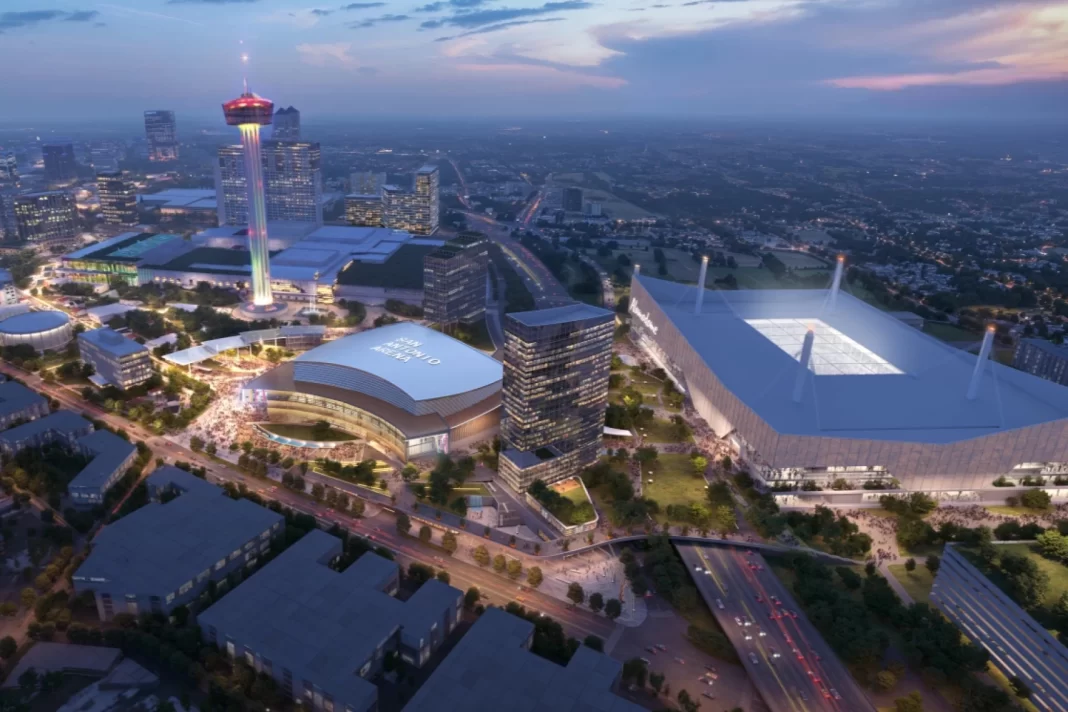The San Antonio City Council received an updated briefing on Project Marvel, the proposed major downtown sports and entertainment district that would center on a new arena for the San Antonio Spurs, that included estimates for how much the district’s developments would cost and the potential funding sources the city is considering.
The new Spurs arena alone has an estimated cost of between $1.2 billion and $1.5 billion, and is proposed to be placed on the current site of the Institute for Texan Cultures (ITC).
Other Project Marvel projects include upgrades to the Alamodome, expanding the Henry B. Gonzalez Convention Center, adding a new Convention Center Hotel, creating a land bridge connector over I-37, the renovation of the John Woods Courthouse into an events venue, and roughly 50 acres of mixed-use development.
The estimated tally for Project Marvel so far is as high as $3.3 billion.
The city council was also briefed on the draft version of the non-binding Memorandum of Understanding (MOU) between Bexar County, the City of San Antonio, and the Spurs that the county approved on Tuesday. That MOU lays a framework for how they will fund the arena and the redevelopment of the Frost Bank Center and Freeman Coliseum.
Convention Center expansion cost is estimated to be up to $900 million, the Wood Courthouse renovation costs are estimated to be up to $150 million, and the Convention Center hotel is estimated to cost upwards of $750 million. Projections for the Alamodome, land bridge, ITC and surrounding federal properties, and infrastructure upgrades are not yet available.
The documents outline six potential funding sources for the Spurs arena — the Spurs, the Bexar County venue tax, private funding, the Hemisfair and MidTown Tax Increment Reinvestment Zones (TIRZs), and a Project Finance Zone (PFZ).

Property taxes were explicitly listed as off-limits for the arena, and several council members emphasized that the city would not raise resident property taxes to pay for Project Marvel.
“I think the number one important thing that hopefully the community hears today, and maybe the press will write, no residential property taxes will go into project Marvel,” District 1 Councilmember Sukh Kaur said. “Maybe that can be a headline.”
Some experts like UTSA public administration professor Heywood Sanders have called that commitment against using property taxes in the past “a peculiar piece of sleight of hand.” They point out that a TIRZ operates by taking property taxes generated from new development within a certain geographic boundary and reinvesting those taxes into improvements for that geographic area.
Those tax dollars from TIRZs would otherwise go into the city’s general fund if they were not diverted.
“I want to be clear, just because a TIRZ is created that captures those general fund dollars before they hit the general fund, it doesn’t change the fact that those are public dollars,” District 5 Councilmember Teri Castillo said.
Castillo also pointed to the other costs associated with these developments that would likely come from the city’s general fund, including the law enforcement needs to secure and control traffic around sports complexes and major venues.
And that doesn’t take into account how an explosion of development downtown will likely affect nearby property values, and therefore nearby property taxes.
“That’s not a Project Marvel issue or an East Side revitalization issue. That’s a city and state issue,” Mayor Ron Nirenberg said. “It is embedded as part of our strategy on housing and so as it relates to property values rising and putting pressure on disadvantaged residents, lower income residents, we are focused on that and utilizing the tools that we have in creating new ones if we get cooperation from the legislature.”
The Bexar County venue tax includes a 1.75% tax on hotel room stays within the county. State law allows the hotel room tax to go as high as 2%, but any increase in the county venue tax requires voter approval. The county, city, and Spurs organization are aiming for a vote in November; the Bexar County Commissioners Court would need to call that election by August.
PFZs are designated three-mile zones around qualifying projects in which the state’s growth in hotel-associated revenue, like the Hotel Occupancy Tax, is captured over 30 years. This revenue can then be used on improvements to the qualifying projects.
The Alamodome and Convention Center are already designated as qualifying projects, and the city intends to designate the new Spurs arena as a third qualifying project. The state of Texas has not yet approved this designation.

Funding from yet unspecified public-private partnerships will also be considered to pay for the arena.
Infrastructure costs for the area around the district, though there is so far no projection, will be largely shouldered by the city’s Capital Budget.
The Capital Budget is funded by city-issued general obligation bonds, certificates of obligation, revenue bonds, and anticipation notes — debt instruments cities routinely use to raise capital, some of which are ultimately backed by property taxes.
The city council will vote on allowing City Manager Erik Walsh to pursue the non-binding MOU with Bexar County and the Spurs on Thursday.
Several council members raised concerns with a section of the MOU that stipulated the city could give the Willow Springs golf course plot on the East Side to the county, and potential revenue generated from development on top of it.
“All this does is open up the opportunity to lose green space, develop a hotel or other development in the hopes that the community will view that as economic development, which I will emphasize, is not what they want,” District 2 Councilmember Jalen McKee-Rodriguez said.
If the council gives Walsh the authority to pursue a MOU, in-depth formal negotiations between the parties and a public engagement process can begin.



